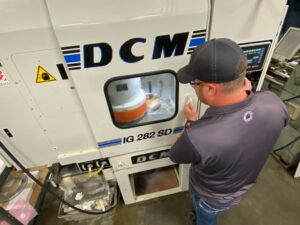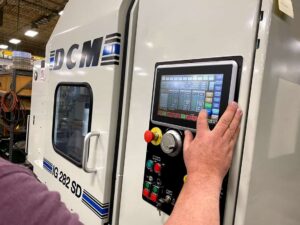Advanced Rotary Surface Grinders Deliver “Endless Possibilities” and Tighter Tolerances
Machine shops that grind metal or alloy surfaces flat to remove material or achieve a precise thickness now have “endless possibilities” to improve their precision as well as production speed and control with more advanced, automated units. Today’s rotary surface…
Posted: October 28, 2023

Machine shops that grind metal or alloy surfaces flat to remove material or achieve a precise thickness now have “endless possibilities” to improve their precision as well as production speed and control with more advanced, automated units.
Today’s rotary surface grinders offer sophisticated sensors and controls that can reliably achieve tighter dimensional tolerances, flatness, parallelism, and surface finish in much less time. The equipment can be used to grind flat metals, alloys, and ceramics to precise dimensions before polishing.
Operator control over the process is unsurpassed with the new automated grinders. The user can enter the specific requirements, for example: 712 RPMs on the spindle, 22 RPMs on the table, with a down-feed rate of .003 inches per minute, with a certain dwell cycle. Essentially, the machine can be programmed to meet just about any requirement.
Compared to traditional grinding equipment with manual controls that require experienced machinists familiar with the nuances of each machine, these automated units consistently produce higher quality parts in less time. As a result, a growing number of machine shops are installing new grinders that can be operated by less experienced personnel while still achieving the desired results.
Solving the Skilled Operator Retirement Problem
In machine shops that work with metals and alloys, factors such as thickness, parallelism, and surface condition are often dictated in the specifications. Grinding is also often utilized to remove significant amounts of material to bring a stock sheet or plate to precise dimensions.
To do this, machine shops primarily utilize surface grinders with a reciprocating table and a horizontal spindle that turns the grinding wheel, but the process is very slow.
“Reciprocating table grinders are precise, but the material removal rate is slow and multiple passes are required,” says Erik Lawson, Engineering Manager at Winona, MN-based DCM Tech, a designer and builder of industrial rotary surface grinders.
Older rotary surface grinders are another option but can be problematic in the hands of less experienced operators. With limited control of spindle speeds as well as manual controls, the older equipment requires sophisticated operators that can factor in complex calculations. Considerable expertise and experience are required, which can be a challenge as skilled operators retire.
Automated Rotary Surface Grinders
In modern vertical spindle, rotary table surface grinders, the table rotates with the workpiece held firmly in place underneath a vertical spindle. The grinding is not performed by the peripheral edge of the wheel, but by the entire diameter of the abrasive surface, which facilitates grinding performance and consistency.
“With rotary table surface grinders, the entire part passes through the wheel, which is more efficient than reciprocating table grinders that may have workpieces wider than the grinding wheel,” says Lawson.
Today, surface grinders are designed with much more advanced sensors and controls that automatically maintain very tight tolerances, removing material down to within one ten-thousandth of an inch of the final thickness. Digital technology allows for an interface with easy-to-use touchscreen controls. When combined with automation, surface grinder operators are no longer required to be highly trained individuals.
For example, rotary units such as DCM Tech’s IG 280 SD, with a 24″ variable speed table and 20HP variable speed grinding spindle motor, make it possible for virtually anyone to successfully operate a unit. One example of innovation available in this model involves the automation of the initial contact between the abrasive wheel and the part, which typically had to be finessed by the operator. With this updated option, advanced sensor technology detects vibration and can automatically fine-tune not only the pressure of the spindle motor but how quickly it moves the wheel down onto the part. When the machine senses the abrasive wheel has contacted the part, it automatically begins the grind cycle.
“Automatic part detection eliminates the need for the operator to do time consuming, error prone ‘manual touch offs’ where they would manually feed the [grinding] machine until it just touches the surface of the part before backing off and restarting it,” says Lawson.
With regard to production efficiency, the advanced rotary surface grinders are also much faster than reciprocating grinders because the units can get much closer to the required precise dimensions before any finishing steps. This capability can reduce or even eliminate some lapping and polishing steps.
With a conventional surface grinder, if stock with standard thickness needs to be ground down, an operator would stop short of the required removal and leave an unpolished surface. Using another machine was often required to remove the remaining material but this can take excessive time and labor.
“A rotary surface grinder will usually finish the work of a reciprocating grinder in a fraction of the time. For the manufacture of carbide blocks, one OEM was able to document a 14X improvement in cycle time by replacing a reciprocating grinder with a DCM rotary surface grinder,” says Lawson.
The process also consistently achieves high throughput and eliminates variability, which enables machine shops to achieve high-quality final parts, batch after batch.
Easy to operate machine controls

In addition, programmable Human Machine Interface (HMI) controls allow operators to enter virtually any requirement into a touch screen. This capability enhances shop processing flexibility, so it is easy to adjust any grinding factor to prevent an issue from reoccurring.
For routine processes the use of a variety of grind “recipes” with sets of parameters for specific parts can further speed production, enhance quality, and aid in quick changeover.
“Different grind recipes can be set for different customers, material types, or even part numbers so complex programming or data does not need to be entered at the start of each job. A new recipe can be created for job variations, such as a different finish or number of parts,” explains Lawson.
The grinder can also be programmed to take corrective actions on subsequent passes if the workpiece is a little off on the first pass. There is no need to pick up the workpiece and measure it after every move as with older machines.
According to Lawson, the automation provided by advanced rotary grinders allows operators to set up the machine and then attend to other tasks. The machine does not need to be constantly monitored because it has built-in load monitoring.
“Load monitoring allows the user to set limits so the machine does not overtax the part being ground or overload the spindle. If something a little unusual happens it can continue without interruption or shutting down,” says Lawson.
He adds that the automated units also contribute to a safer, cleaner shop environment because the grinding is accomplished under an enclosed shroud that contains the debris and prevents it from entering the work area.
As the tolerances for metal and alloy grinding become stricter and production requirements more demanding, machine shops that take advantage of advanced, automated rotary surface grinders will outperform rivals even as experienced operators retire.
“With automated rotary surface grinders, a machinist can be trained to be proficient at operating the equipment by lunch on the first day. It just takes a few hours of training, not decades of experience as with older machines,” concludes Lawson. He adds that systems incorporating full automation are now being developed that will use a robot to load, set up, and run parts without an operator nearby.












